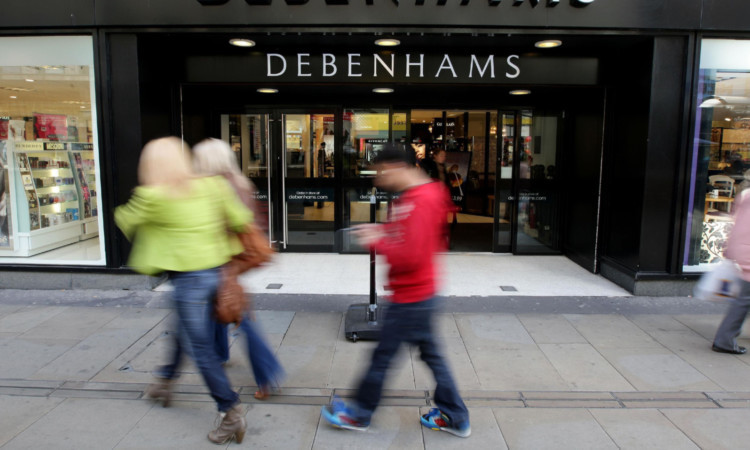
Falling sales and furious customers have tarnished Debenhams’ reputation.
Once it was a high street hero, a store with a proud 200-year history but in touch with what modern shoppers wanted. But after a disastrous Christmas many are wondering what’s next for Debenhams.
The towels to tights store group issued a profits warning on Hogmanay, admitting it didn’t get the anticipated huge surge in sales in the run-up to Christmas. Analysts predicted its profits for the first half of its tax year would be £85 million.
Big sums for sure but a plunge of 26% on the previous year. In business terms, it’s nothing short of a disaster. It’s not just that the tills failed to ring over Christmas. Some customers who did put their hands in their pockets have major gripes, too the list of complaints on Debenhams’ own Facebook page seems endless.
No major business gets their customer service right 100% of the time. But it’s the sheer anger of Debenhams’ customers who have gripes that is noticeable. There are customers calling them “thieves”, complaining about being left on hold for an hour after requesting to speak to a manager, and fighting to get hundreds of pounds back after allegedly receiving damaged furniture.Post by Debenhams – the official page.The Debenham’s Facebook page attracts a lot of angry comments from aggrieved customers
According to retail consultant Anusha Couttigane, of retail research agency Conlumino, Debenhams’ biggest problem over Christmas was the fact that other retailers started sales before Christmas, which meant they also had to slash prices.
“Debenhams has a reputation for promotional activity and it’s become something customers expect as standard,” she says. “When all retailers are offering discounts, Debenhams has to work harder to give the impression of value for money. Debenhams had to discount just to get people through the door.”
In a way, you could argue Debenhams have become victims of their own success. Once, their Designers at Debenhams ranges where top designers had their own, cheaper lines on sale in the store were unique and a big draw. Now, other shops like H&M have got in on the act.
“It’s no longer an original idea. Once it was a point of distinction for Debenhams, now even value chains like New Look and George are offering similar collections,” says Anusha.
Edinburgh-based fashion stylist and commentator Ian Tod agrees.
“Some of their clothes just aren’t right,” he says. “The Star by Julien Macdonald range is just cheap-looking. The John Rocha range looks a bit fuddy-duddy. It probably looks better when you try it on but the problem is that, although people say they love shopping, they hate trying on. So the odds are stacked against it.
“The public is much more savvy than they used to be about designers, too. They know that if they buy, say, a Jasper Conran dress from Debenhams, they’re not getting a high end design that you’d get if you bought straight from Jasper Conran. The accessory section is a bit duff, too. What it comes down to is if you haven’t got what the public want, you won’t sell it.”
Ian believes the Debenhams shopping experience just isn’t as nice as you find in other, comparable stores.
“John Lewis gets it right. Their stores are so well laid-out and spacious. Debenhams can feel a bit of a jumble. And House of Fraser in Glasgow is a pleasure to shop in. It helps because they’ve got a fantastic building which is full of character, but inside it’s great. It makes customers want to go there, it’s special.”
The fact so many customers appear disgruntled at the service they’ve received doesn’t surprise Ian.
“To be fair, that won’t be exclusive to Debenhams. So many big stores at Christmas take on temporary staff. They’re not as well-trained, they’re often only there for the money and even if they are trying to help, they’ve probably been rushed off their feet.”
Anusha believes Debenhams can turn their fortunes around maybe even learn a trick or two from their competitors.
“Both House of Fraser and Next have benefited from extremely smooth and efficient ‘multichannel’ operations, like next day delivery and click and collect. Debenhams needs to create a more positive, personal experience throughout the year so that, rather than expecting customers miraculously at Christmas, it can count on repeat custom.
“This would also mean stores were well-staffed with well-trained advisors it can radically transform customer perceptions when staff are on the ball.”
Anusha warns that none of our high street giants can rest on their laurels. “We’ve already seen signs of major players like Marks & Spencer and Monsoon beginning to decline. However, no one is really ‘safe’, as customer loyalty is very fickle.”
It seems no stores are secure on the high street. It can only mean one thing for the consumer, at least in the short term a fight for your custom.
A spokesperson for Debenhams said: “Customer service is at the heart of our business serving hundreds of thousands of people. We have recently moved to a state of the art customer contact centre and have the capability of dealing with customers be it by letter, email, telephone or social media channels.”

Enjoy the convenience of having The Sunday Post delivered as a digital ePaper straight to your smartphone, tablet or computer.
Subscribe for only £5.49 a month and enjoy all the benefits of the printed paper as a digital replica.
Subscribe